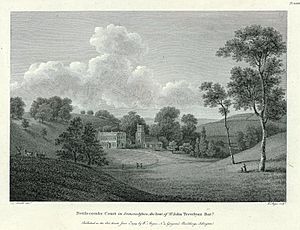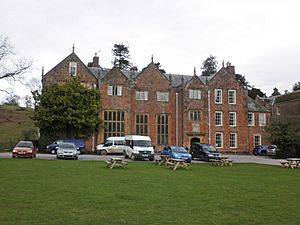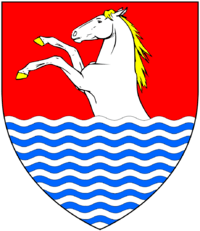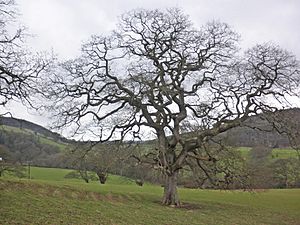Nettlecombe Court facts for kids
Quick facts for kids Nettlecombe Court |
|
|---|---|
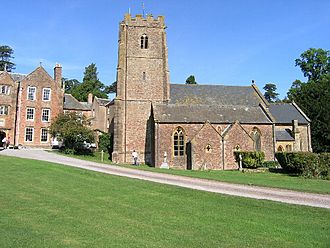
Nettlecombe Court Field Centre and the Church of St Mary the Virgin
|
|
| General information | |
| Town or city | Williton |
| Country | England |
| Coordinates | 51°07′52″N 3°21′00″W / 51.131°N 3.35°W |
Nettlecombe Court and its park are a very old estate located near the Brendon Hills in Exmoor National Park. It's in the small village of Nettlecombe, about 3.6 miles from Williton in Somerset, England. This historic place is so important that English Heritage has given it a special Grade I listed building status.
The estate includes a large mansion, a medieval hall, a church, and a farm. It is surrounded by 60 hectares (148 acres) of parkland, which is part of Exmoor National Park. The park is also listed as a Grade II historic park.
Today, Nettlecombe Park is home to the Leonard Wills Field Centre. This centre is run by the Field Studies Council. It offers outdoor learning experiences for schools, colleges, and universities. You can also find holiday accommodation and courses in nature and art here. The nearby hills and woodlands, including Exmoor National Park, are perfect for learning about the environment and plants.
Contents
A Glimpse into Nettlecombe's Past
Nettlecombe was first called Netelcumbe, meaning "the valley where nettles grow." By 1245, it was known as Nettelcumbe.
This estate has a unique history because it has never been bought or sold. Before the Norman Conquest, it belonged to Prince Godwine, son of King Harold. After King Harold lost the Battle of Hastings, William the Conqueror took control of Nettlecombe.
In 1160, King Henry II gave the estate to Hugh de Raleigh. It stayed in the Raleigh family for centuries, passed down through their bloodline. Later, in 1481, it became part of the Trevilian family (now spelled Trevelyan) through a marriage. The Trevilian family owned Nettlecombe until the 20th century.
In the late 1950s, Nettlecombe Court became a girls' boarding school. Since 1967, it has been the Leonard Wills Field Centre. The park around the house, called Nettlecombe Park, is a special area for nature, known as a Site of Special Scientific Interest (SSSI).
Exploring Nettlecombe Court's Architecture
Nettlecombe Court is a grand Elizabethan country house. It also has older parts, like a medieval hall and an impressive entrance. A Tudor-style room was added in 1599. In the 1640s, more parts were built after a fire. This fire was started by people who were against George Trevelyn's support for the king during the English Civil War.
Between 1703 and 1707, during the time of King George I, the southwest side of the house was made larger. The southwest wing was decorated in the 1780s. In the early 1800s, a new service area was added. The house still has beautiful plasterwork from all these different periods.
In the 1600s, a large organ was installed in the house. In the 1980s, parts of this organ were moved to the John Loosemore Centre. They are still there, waiting to be put back together.
The Families of Nettlecombe
Nettlecombe is first mentioned in the Domesday Book of 1086. It was owned by William the Conqueror and managed by his sheriff for Somerset, William de Mohun.
The Ralegh Family
In the mid-1100s, the manor of Nettlecombe was given to Hugh de Ralegh, a Norman knight. His nephew, Warrin de Ralegh, built a manor house where Nettlecombe Court stands today. The Court's kitchen might even be part of that original 12th-century Great Hall. Warrin de Ralegh also built a small church next to the manor house. Many Ralegh family members are remembered inside this church.
The last Ralegh owner of Nettlecombe Court was Sir Simon, who died in 1440. He left the estate to his nephew, Thomas Whalesborough. Sir Simon's will included money to build a special chapel in St Mary's Church. This chapel, now the south aisle, was meant for a priest to pray for the Ralegh family forever.
The Trevilian-Trevelyan Family
The estate passed to the Trevilian family in 1452. This happened when Elizabeth Whalesburgh, the heiress of the estate, married Sir John Trevilian. He was a knight who served King Henry VI. He also worked as a Member of Parliament for Somerset. In the 1600s, the family name started being spelled as Trevelyan.
Sir John Trevilian was very active in the royal courts. He received royal pardons multiple times. To show his thanks for these pardons, Trevilian gave a special chalice and paten (church plates) to Nettlecombe's St Mary's Church. These are the oldest British hallmarked church plates in the United Kingdom. Today, you can see them at the Victoria and Albert Museum in London.
Around 1458, a beautifully carved octagonal font was made for the church. Around 1500, a later John Trevilian built the west bell tower. The church also has a carved wooden screen with his family's coat of arms.
In 1530, Trevilian rebuilt and improved Nettlecombe Court, making it look much like it does today. He kept some favorite parts of the older medieval manor house. Around the same time, the church porch and north aisle were built, followed by the Trevilian Chapel.
Challenges and Hidden Treasures
Nettlecombe Court faced tough times during the Reformation and the English Civil War. The Trevilian family remained loyal to King Charles I. Because of this, in 1645, the rector of Nettlecombe Court's St Mary's Church, along with his parishioners, set Nettlecombe on fire. They were angry that the Trevilian family would not join the Church of England. The fire badly damaged the Great Hall.
Despite this, the Trevilian family stayed loyal to the king. Instead of changing their faith, they built a private chapel at Nettlecombe Court. It even had a secret hiding place for Catholic priests who visited.
During the English Civil War, Colonel George Trevelyan fought for the king. He was captured and imprisoned. Oliver Cromwell's soldiers came to Nettlecombe to take anything valuable. George's wife, Margaret, hid the family's silver and other treasures under the floorboards. Sadly, she died before she could tell her husband where they were. The hidden treasure was not found again until the 1790s!
Lady Margaret Trevilian bravely went to London to ask Parliament to reduce the high payments they demanded from Nettlecombe Court because of the family's loyalty to the king. Parliament refused her request. On her way home, Lady Trevilian died, leaving her nine children without a mother. The family jewels and silver remained hidden for over a century. A maidservant accidentally dropped a needle through a loose floorboard. When they pulled up the board to get it, they found the long-hidden valuables!
After the monarchy was restored under Charles II, George Trevilian was given a special honor for his loyalty. The family name was changed to Trevelyan. Later, in 1787, a generation of Trevilian-Trevelyans converted to the Church of England to avoid further problems.
St Mary's Church
The story of Nettlecombe Court and its church are closely linked. The church was restored in 1858. In 1935, a 13th-century marble altar stone was found buried in the churchyard and returned to its place inside the church.
Other historical items in Nettlecombe Church include an old medieval chest and several medieval tiles. There are also memorial tablets and tomb slabs for members of the Trevilian family. The church has a rood screen from the late 1400s and carved bench ends from the 1500s. The beautifully carved pulpit is from the late 1600s, and there are some lovely 17th-century stained glass panels.
A Place for Thinkers and Artists
In the 1800s, Lady Trevelyan used her family estates, including Nettlecombe, to host a famous gathering of thinkers and artists. This was known as a "salon." It was especially known for its connection to the Pre-Raphaelite Brotherhood, a group of artists.
The sister of the famous British historian Lord Thomas Macaulay married into the Trevelyan family. This led to another important historian, George Macaulay Trevelyan, whose ancestors lived at Nettlecombe.
The Trevelyan Family Arms and a Legend
Nettlecombe Court has many carvings and emblems showing a horse rising from the sea. This is the Trevilian family's coat of arms. It comes from the legend of Lyonesse.
Lyonesse was a mythical land on the west coast, now underwater. It was said to be part of King Arthur's Camelot and the site of his final battle. The poet Tennyson even suggested Lyonesse was King Arthur's final resting place. This might explain why his grave has never been found.
Legend says that when Lyonesse suddenly sank, only one knight, Trevilian, escaped. He rode his white horse through the rising waters to higher ground. The other knights stayed behind, joking and betting that Trevilian couldn't survive. None of them, except Trevilian, survived the sinking of Lyonesse. It's said that on stormy days, you can still hear the muffled ringing of the medieval church bells from the lost land, deep under the water.
The surviving Trevilian became the founder of the current British Trevilian-Trevelyan family. Their coat of arms still shows a white horse coming out of the sea. At Nettlecombe, you might see the Trevilian horse combined with other family arms, showing marriages to families like Raleigh, Luttrell, and Strode.
Nettlecombe Park: A Natural Treasure
| Site of Special Scientific Interest | |
| Area of Search | Somerset |
|---|---|
| Interest | Biological |
| Area | 90.4 hectare (223.4 acre) |
| Notification | 1990 |
| Location map | English Nature |
Nettlecombe Park is very important for its lichens (small plant-like growths). Records suggest this area has been open woodland or parkland for at least 400 years. Some very old oak trees, called pollards, might be even older. The oldest trees are over 200 years old.
Because this open woodland and parkland has existed for so long, with many old trees, special kinds of lichens and beetles have been able to live and thrive here. Many of these species are now rare in Great Britain because their natural habitat has disappeared in many places. The park was officially recognized as a Site of Special Scientific Interest (SSSI) in 1990.
Nettlecombe had a deer park by 1532. In the 1690s, large parts of the parkland were fenced off, and four new gardens were created. One was a water garden, which is now gone but remembered in the name 'Canal Field'. The park was made larger in the 1700s. This involved moving the houses that made up the village. In 1792, the landscape was redesigned, including building a Ha-ha (a hidden ditch) between the deer park and the meadows. This also meant moving cottages and their residents. The parkland is now listed as a Grade II historic park.
Inside the park grounds is the Church of St Mary the Virgin. This church is also a Grade I listed building.
The Famous Oak Trees
Nettlecombe Park covers 223 acres (90.4 hectares) of rolling parkland. It has huge, single trees and groups of trees. It was probably once mostly an oak forest. Today, oaks and sweet chestnuts are still the most common trees. Some of the sessile oaks are incredibly large and were famous long ago for their size.
Nettlecombe oaks were once used to build tall, strong ships. During the time of Queen Elizabeth I, timber from Nettlecombe's oaks was chosen to help build the ships of the English fleet. This fleet, led by Sir Walter Raleigh, defeated the Spanish Armada. Many other English ships that sailed the world to establish British colonies were also built using prime Nettlecombe oaks.
In the 1800s, the Trevelyan baronet was offered a lot of money to cut down and sell these great oaks. But the owner chose to leave them standing, and the trees have been protected ever since. Some of them now have a trunk size of 23 feet around! Today, acorns from Nettlecombe are sold to nurseries to grow new oak trees.


